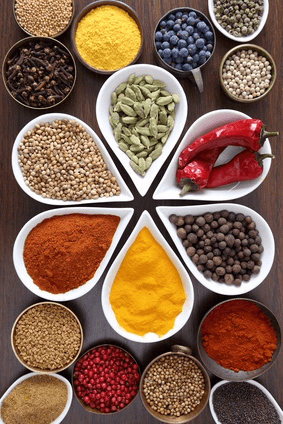THE FLAVOR INDUSTRY
 The Flavor Industry is a fascinating world which has historically been kept secret, known only to those who dedicate their lives to it. Since 2004, The Perfumer’s Apprentice has been endeavoring to help people learn about the world of perfumery, providing education and materials to students of all levels. Now, The Flavor Apprentice hopes to provide help and information to those interested in the world of flavors as well.
The Flavor Industry is a fascinating world which has historically been kept secret, known only to those who dedicate their lives to it. Since 2004, The Perfumer’s Apprentice has been endeavoring to help people learn about the world of perfumery, providing education and materials to students of all levels. Now, The Flavor Apprentice hopes to provide help and information to those interested in the world of flavors as well.
THE FLAVORS
Traditionally, flavor and fragrance formulas have been closely guarded as ’Trade Secrets’, and information about them is not normally available to the general public. In the flavor industry, ingredients lists for consumer products are only required to declare the non-flavor ingredients, such as Propylene Glycol, Ethyl Alcohol, or Triacetin. The flavor compounds themselves are generally referred to as Natural Flavors or Artificial Flavors, with no further detail required.
It is a requirement of the FDA that only certified Food Safe materials are used in the creation of flavors, and flavor manufacturers are inspected regularly to make sure all requirements are met. However, with the advent of GC/MS analysis, any person has the capability to have a flavor or fragrance analyzed. the end result being a listing and rough percentage of the molecules contained in the blend. In effect, this has resulted in the lessening of the secrecy behind flavor formulation, and has shed more light on the fascinating world of raw materials.
All professional flavors are made from various types of raw materials, blended together to achieve limitless finished flavors. Flavors are endlessly nuanced and can range not only from sweet to savory, but also from fruity to buttery, caramellic, smoky, sharp, soft, cheesy, toasty, and beyond. They can be used in a wide variety of applications from general food preparation to edible cosmetics and beyond. New applications for flavor concentrates are discovered all the time.
There are different types of raw materials used, ranging from essential oils, extracts, distillates, all the way to individual compounds. Both perfume and flavors are often made from the same aroma compounds. The palette of flavor compounds is a subset of the wider world of fragrant compounds. A simple vanilla flavor might consist of vanillin, ethyl vanillin, and ethyl maltol. These compounds can also be found in fragrances such as Guerlain Spiritueuse Double Vanille, Jean Paul Gauthier Classique, Guerlain Shalimar, Dior J`Adore L`Absolu, and many more. In this sense, all flavors have perfume ingredients.
What is the difference between fragrance and flavor, then? A flavor will consist only of ingredients that are certified as Food Safe. Professional Flavorists learn the individual characteristics of these flavor materials, and through education and experience learn how to blend them into the flavors for anything from finished food products to direct consumer/hobbyist sale.
THE INDUSTRY
Professional Flavors are part of a larger world called the Flavor and Fragrance Industry, represented by large, international fragrance and flavor companies like International Flavors and Fragrances (IFF, based in New York), Givaudan, and Firmenich (based in Switzerland), to name just a few. These are the companies that create and produce the raw materials of the fragrance and flavor industry, as well as many of the best-known final fragrance and flavor blends. Some flavor and fragrance companies specialize in flavor manufacturing, but no matter how big or small, all flavor manufacturers are subject to very rigorous requirements, especially in the U.S.
The traditional hierarchy of the Flavor Industry is as follows:
- Manufacturers of raw materials
- Flavor/Fragrance Blending Houses
- Flavor/Fragrance/Raw Material Distributors (wholesale/commercial sizes)
- Flavor/Fragrance/Raw Material Distributors (retail/hobbyist sizes)
Manufacturers come in many sizes, from companies who sell thousands of compounds in sizes from 1 kilo to more than 250 kilos, all the way manufacturers that specialize in producing just a few raw materials, located all over the world. Several manufacturers act as distributors in wholesale sizes sold to other companies.
There are many Flavor/Fragrance Houses that use these raw materials to create flavors. In general, these companies do not sell their flavors directly to consumers, rather, they design their flavors to be used in a specific application such as coffee, bakery products, beer brewing, or candy.
Finally, there are distributors that offer these flavors, fragrances, or raw materials to the general public. The Perfumer’s Apprentice and The Flavor Apprentice both act as a retail and small wholesale distributors in their respective areas.
The Flavor Apprentice works primarily with 3 flavor houses which design and manufacture private label finished flavors, none of which sell to the public. By using flavor houses, we benefit from the decades of experience of their flavorists, as well as a lower price because of their ability to purchase larger volumes of raw material. Our partnership with private label flavor houses also allows us to pass the benefits of high-quality, affordable flavors on to our customers!
